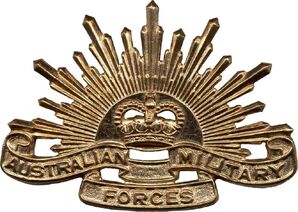m (Reverted edits by 172.90.104.193 (talk | block) to last version by ISAFollower) |
No edit summary Tags: Visual edit apiedit |
||
| Line 1: | Line 1: | ||
{{Stub}}{{construction}}{{RA}} |
{{Stub}}{{construction}}{{RA}} |
||
| + | [[File:Anzac-badge.jpg|thumb|298x298px|Coat-of-Arms of the ANZAC.]] |
||
{{Infobox/unit |
{{Infobox/unit |
||
|image = |
|image = |
||
Revision as of 16:35, 25 December 2016
| This article is a stub. It is short and in need of fortification. Why not help out? |

|
Incoming! The subject of this article is a recent or unreleased addition to a Battlefield game. It may contain speculation or errors. Have new, relevant information to add? Why not help out? |

Coat-of-Arms of the ANZAC.
The Australian and New Zealand Army Corps (ANZAC) were an army corps of which comprised troops from the First Australian Imperial Force and 1st New Zealand Expeditionary Force during the First World War until it disbanded in 1916 after the Allied evacuation of Gallipoli.
Today, ANZAC are revered in both Australia and New Zealand as the two nations celebrate Anzac Day every April 25 to commemorate the corps' actions during the war.[1]
Battlefield 1
ANZAC are featured in the single player campaign of Battlefield 1, particularly in the chapter The Runner, where members of the corps engage in heavy combat against forces of the Ottoman Empire during the Gallipoli Campaign.
Trivia
- Australia and New Zealand were under British command as both countries were part of the commonwealth.
- Both countries wore British military uniforms, but the Slouch Hat with the cocked up side were mostly worn by the ANZAC's both by Australians and New Zealanders. New Zealand maintains most military headwear but still use two styles of Slouch Hat to this day (Often referred to as a 'Bush hat' by Kiwis.)
- Units were sometimes mixed with both countries, therefore that is where the 'mateship' and being seen as ANZACs instead of two separate countries.
